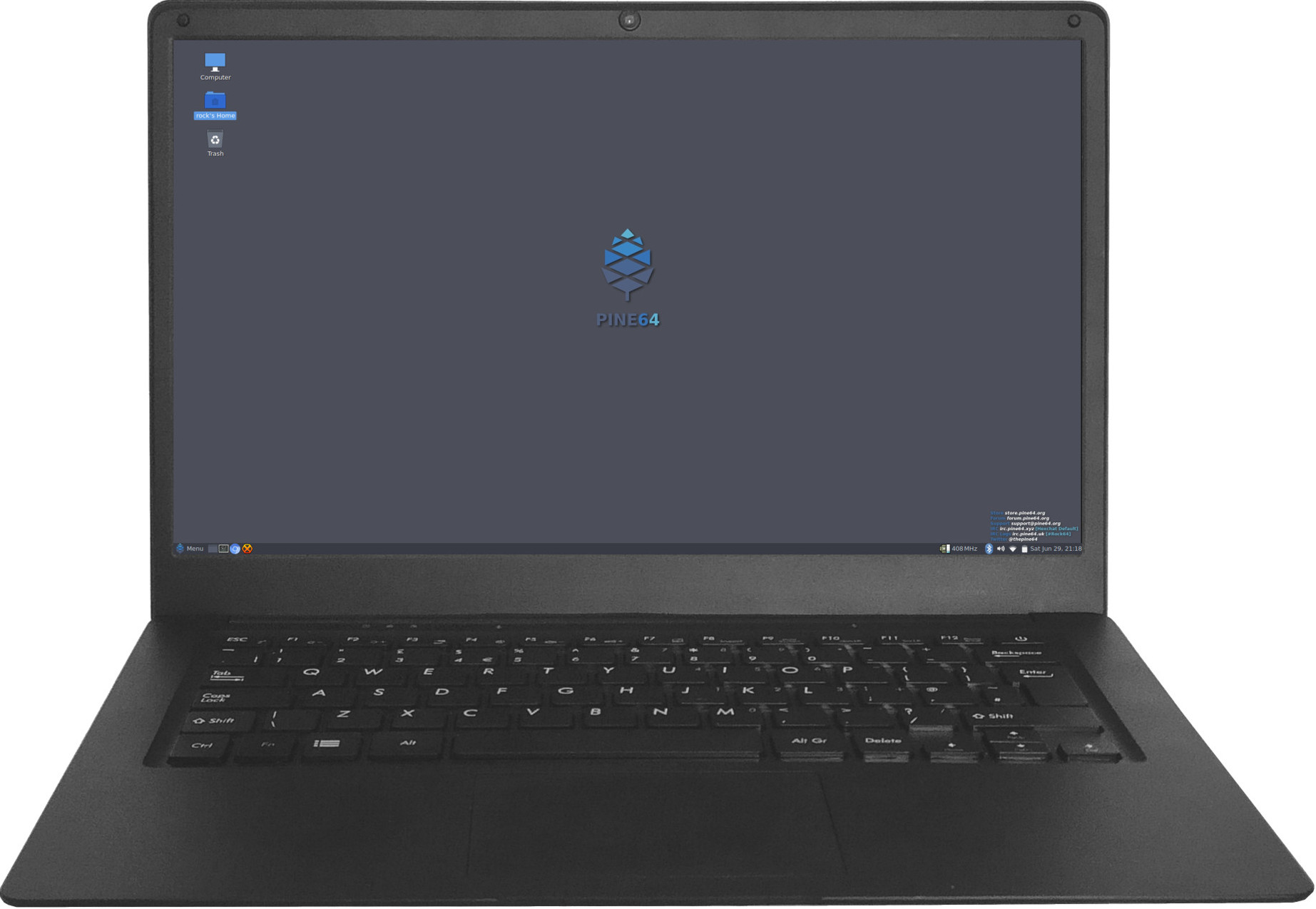Pinebook: Unterschied zwischen den Versionen
(+) |
(+) |
||
| Zeile 1: | Zeile 1: | ||
[[File:Pinebook_14_Inch_with_Ethernet_Adapter.jpg|thumb|Pinebook 14" mit Ethernet-Adapter]] | [[File:Pinebook_14_Inch_with_Ethernet_Adapter.jpg|thumb|Pinebook 14" mit Ethernet-Adapter]] | ||
[[File:Pinebook_11_Inch.jpg|thumb|Pinebook 11,6"]] | [[File:Pinebook_11_Inch.jpg|thumb|Pinebook 11,6"]] | ||
[[File:Pinebook_Pro.jpg|thumb|Pinebook Pro]] | |||
Das '''Pinebook''' ist eine niedrigpreisige 64-Bit-ARM-Notebook-Familie des [[Volksrepublik China|chinesischen]] Unternehmens Pine Microsystems Inc. (PINE64).<ref>[https://www.pine64.org/?page_id=172 Privacy Policy – PINE64]</ref> | Das '''Pinebook''' ist eine niedrigpreisige 64-Bit-ARM-Notebook-Familie des [[Volksrepublik China|chinesischen]] Unternehmens Pine Microsystems Inc. (PINE64).<ref>[https://www.pine64.org/?page_id=172 Privacy Policy – PINE64]</ref> | ||
| Zeile 40: | Zeile 41: | ||
*https://www.pine64.org/ | *https://www.pine64.org/ | ||
*[https://linux-sunxi.org/Pine_Pinebook Pine Pinebook - linux-sunxi.org] | *[https://linux-sunxi.org/Pine_Pinebook Pine Pinebook - linux-sunxi.org] | ||
*{{Commons|Category:Pinebook}} | |||
*{{EN-WP|Pinebook}} | *{{EN-WP|Pinebook}} | ||
Aktuelle Version vom 22. Januar 2022, 15:12 Uhr



Das Pinebook ist eine niedrigpreisige 64-Bit-ARM-Notebook-Familie des chinesischen Unternehmens Pine Microsystems Inc. (PINE64).[1]
Das Pinebook basiert auf der Pine64-Platine und ist mit einem QuadCore 64-Bit-ARM-CPU Cortex A53 Prozessor mit 1,2 GHz Taktfrequenz, 2 GByte RAM und 16 GByte eMMC-Speicher (erweiterbar) ausgestattet. Es gibt ein Modell mit 11,6-Zoll-Bildschirm und eines mit 14-Zoll-Bildschirm. Beide bietet eine Auflösung von 1.366 x 768 Bildpunkten, zwei USB 2.0-Ports, eine Webcam sowie Ethernet, WLAN und Bluetooth 4.0. Die KDE Desktop-Umgebung Plasma wurde von dem KDE-neon-Entwickler Jonathan Riddell unter dem Namen KDE Neon Pinebook Remix auf das Pinebook portiert.[2] Ab Oktober 2019 wurde nach einigen Verzögerungen das Pinebook Pro ausgeliefert.[3] Im März 2020 ging eine neue Charge von Pinebook Pros in Produktion. Diese wurden erstmals mit Manjaro KDE als Vorgabe ausgeliefert.[4]
Technische Daten
Pinebook
- CPU: 1,2 GHz 64-Bit Quad-Core ARM Cortex A53
- Display: 11,6" IPS oder 14" TN LCD (1.366 x 768 Pixel)
- RAM: 2 GB LPDDR3 RAM
- Flash: 16 GB eMMC 5.0 (erweiterbar bis zu 64 GB)
- Tastatur: Schreibmaschinentastatur
- Touchpad: Large Multi-Touch Touchpad
- Anschlüsse: 2 x USB 2.0, microSD, Digital Video, Kopfhörer (Klinkenstecker)
- Verbindung: WiFi 802.11 b/g/n, Bluetooth 4.0
- Mikrofon: Eingebaut
- Frontkamera: 0,3 Megapixel
- Strom: Input: 100~240 V, Output: 5 V / 3 A
- Akku: Lithium-Polymer-Akkumulator (10.000 mAH)
- Maße: 299 x 200 x 12 mm (11,6") / 329 x 220 x 12 mm (14")
- Gewicht: 1,04 kg (11,6") / 1,26 kg (14")
Pinebook Pro
- CPU: Hexa-Core Rockchip RK3399 (4 x ARM Cortex A53 Cores @ 1,4 GHz + 2 x ARM Cortex A72 Cores @ 1,8 GHz)
- GPU: ARM Mali T860 MP4
- Display: BOE NV140FHM-N49 14.0" IPS Panel (1920 x 1080 Pixel)
- RAM: 4 GB LPDDR4 RAM
- Flash: 64 GB eMMC (erweiterbar)
- Tastatur: ISO & ANSI Varianten
- Touchpad: Trackpad (96 x 64mm)
- Anschlüsse: M.2 NVMe SSD (benötigt optionalen Adapter); USB 2.0 (Host); USB 3.0 (Host); USB-C (Data, Strom und Videoausgabe); Kopfhörer
- Verbindung: WiFi 802.11ac; Bluetooth 5.0
- Lautsprecher: Stereo
- Mikrofon: Eingebaut
- Frontkamera: 1080p
- Akku: Lithium-Polymer-Akkumulator (10.000 mAH)[5][6]
Weblinks
- https://www.pine64.org/
- Pine Pinebook - linux-sunxi.org
- Pinebook bei Wikimedia Commons

- Pinebook in der englischsprachigen Wikipedia

Quellen
- ↑ Privacy Policy – PINE64
- ↑ KDE Plasma auf dem Pinebook - Pro-Linux, 24. August 2018
- ↑ Pinebook Pro wird ausgeliefert - Linux News, 7. Oktober 2019
- ↑ PinebookPro pre-orders with Manjaro KDE are now live - Announcements - Manjaro Linux Forum, 18 March 2020 @ Wayback Machine
- ↑ PINEBOOK Pro | PINE64
- ↑ Pinebook Pro - PINE64
